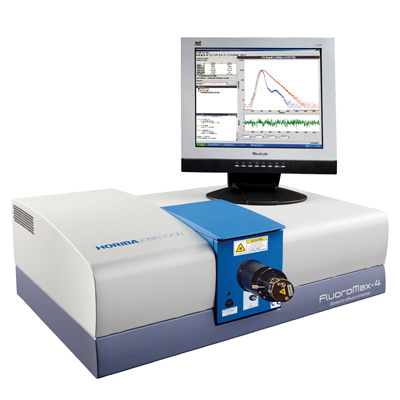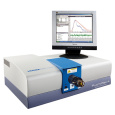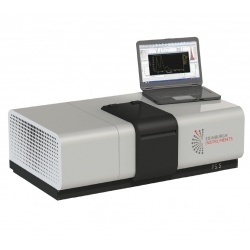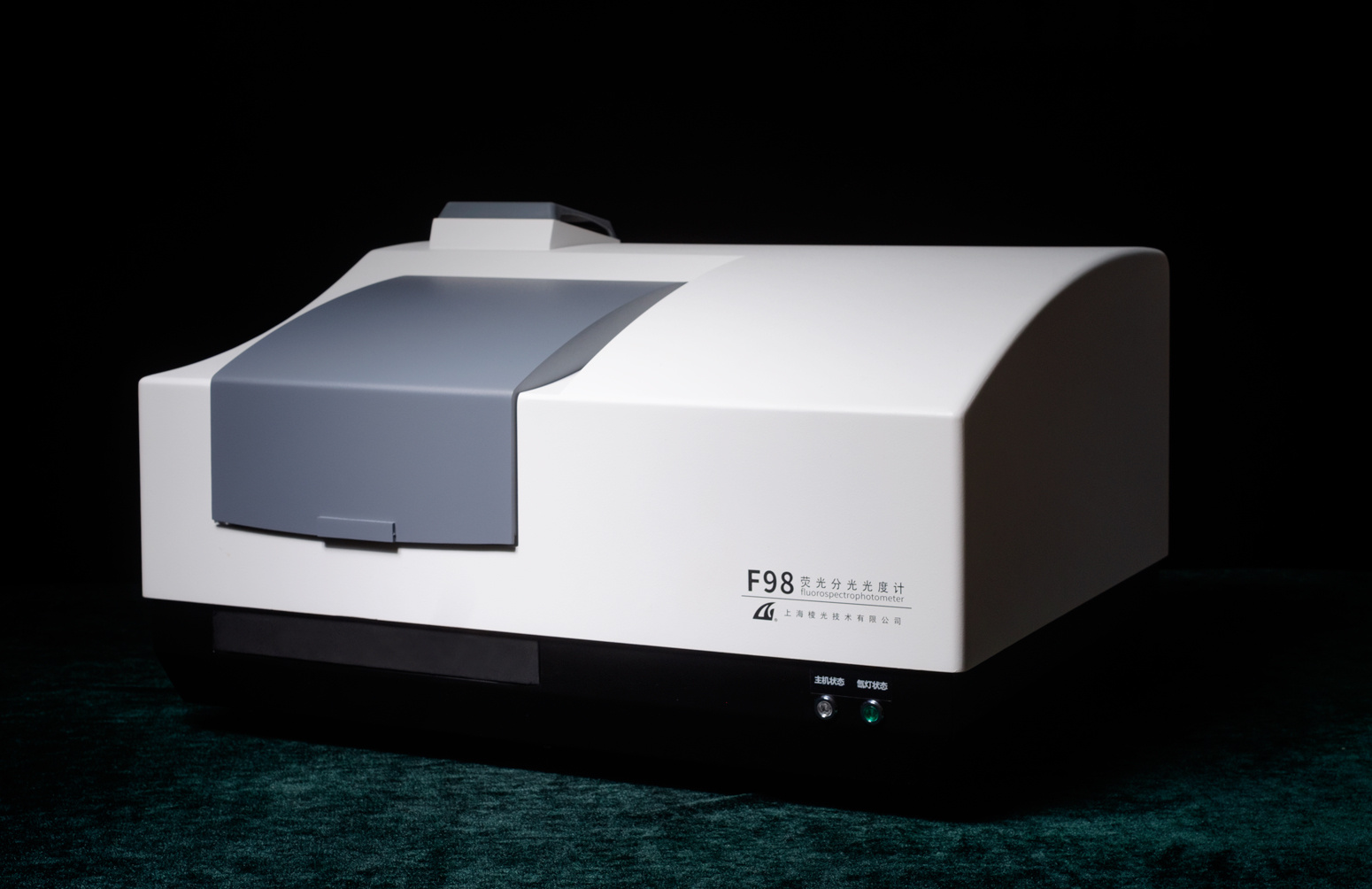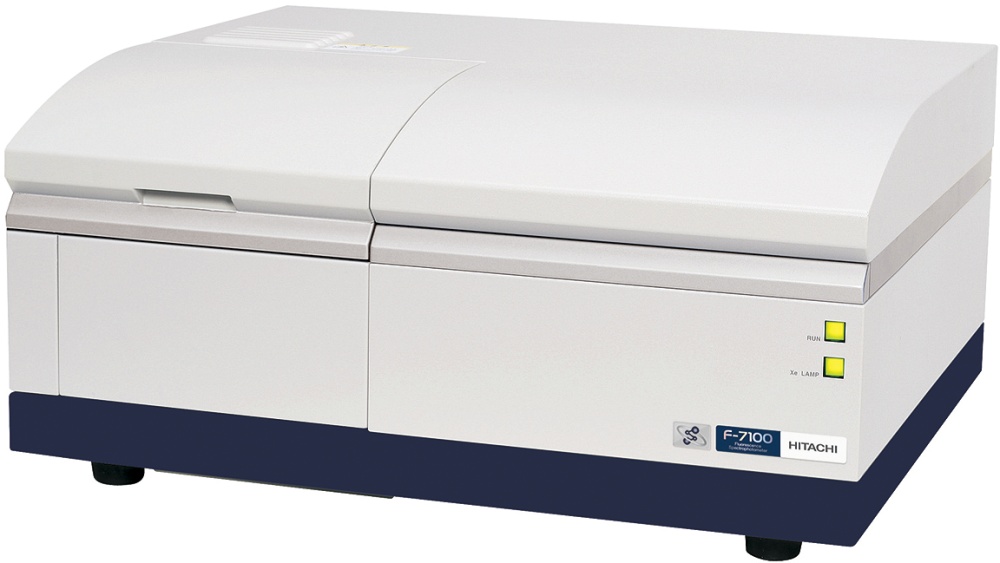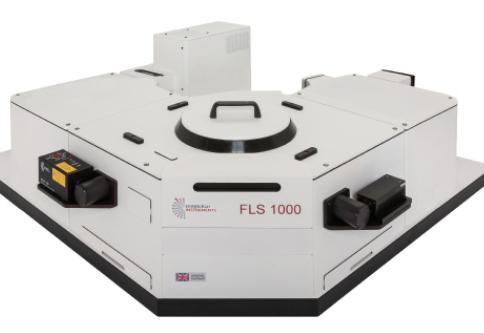方案详情
文
Polarization measurements using HORIBA Jobin Yvon spectrofluorometers are a sensitive tool for probing many biochemical interactions.
方案详情

Fluorescence Anisotropy Studies Introduction Polarized light striking a fluores-cent molecule results in polarized fluo-rescence..This polarizedEemissiongradually returns to unpolarized fluores-cence depending on rotational diffusionand other factors. Anisotropy is directlyrelated to the polarization, and is the ra-tio of the polarized-light component tothe total light intensity. With optional po-larizers installed in a spectrofluorometer,we define light intensities: lv is with ex-citation and emission polarizersmounted vertically; lHH is for excitationand emission polarizers mounted hori-zontally. lHv uses an excitation polarizerhorizontal and the emission polarizervertical; Iv requires the excitation polar-izer vertical and emission polarizer hori-zontal. The basic setup, called“L-format," is shown in Fig. 1. Fig. 1. Diagram of L-format fluorescence polari-zation. Vertical (V) and horizontal (H) orienta-tions of each polarizer are shown. where G, the“G factor,”is Four intensity measurements,, corre-sponding to permutations of both polar-izers’orientations, are needed to deter-mine or P. Both Fluorolog@and FluoroMaxspectrofluorometers with a polarizer ac-cessory can do L-format polarizationmeasurements. The Fluorolog@s modu-lar design, however,.introducesun-equalled flexibility with optional“T-format”polarization. The T-format usestwo emission polarizers, speeding updata-acquisition via simultaneous verti-cal and horizontal polarizer emissionneasurements. A diagram of the T.format method is shown in Fig. 2. Anisotropy provides informationon molecular size and shape, and localviscosities of a fluorophore's environ-ment, as well as offering insight intochanges in molecular sizes of polymersand other macromolecules.Protein-ligand interactions and binding assays ( ' Joseph R. Lackowicz, Principles of Fluores-cence Spectroscopy,3 ed., N ew Y o rk,Springer,2006, pp. 353-354, 361-364. ) can be investigated, and fluorophorelifetimes can be determined. Fig. 2. Diagram of T-format fluorescence polari-zation. Vertical (V) and horizontal (H) orienta-tions of each polarizer are shown. Anisotropy of binding curves Platelet-derivedgrowth factor(PDGF) is a protein in platelets andelsewhere in the human body. Severalisoforms exist (PDGF-AA, PDGF-AB,and PDGF-BB), made of PDGF-A andPDGF-B subunits. PDGF, especially theBB isoform, may promote cell-growthand division. PDGF-BB binds to two B-PDGF-R receptors on the cell mem-brane to activate phosphatidylinositol 3-kinase inside the cell, signaling cellgrowth. Some malignant tumors contain1all(excess PDGF, so this protein may indi-cate cancer. An aptamer (synthetic oligonu-cleotide with two hairpins) was designedto bind to PDGF, and contained fluo-rescein dye at one end. A cuvette with0.1 pM fluorescein-labeled aptamer wasplaced into a Fluorolog@-3 equipped withapolarizer accessory. The emissionmonochromator was parked at 490 nm,while the excitation monochromator wasset to 514 nm. Integration time = 3.3 s,and 1 pM PDGF-BB was injected intothe cuvette (Fig.3). Fig. 3. Anisotropy of 0.1 pM labeled aptimer so-lution. PDGF-BB, 1pM, was added at time=0 s. Fig. 4.Anisotropy of 0.1 pM labeled aptimer so-lution, with varying amounts of 1pM PDGF-BBadded. The brown curve is a control with onlybuffer added to the aptimer. The anisotropy change is detect-able when PDGF is added to the solu-tion. Binding characteristics between theaptamer and PDGF were studied. Fig. 4shows a reproducible possible biphasiccurve; perhaps two aptamers exist withdifferent affinities to PDGF.As a control,buffer without PDGF was added to asecond solution. The control shows nochange in anisotropy as PDGF is added. The detection limit via the anisot-ropy change was found using 2 nM ap-tamer, using a bandpass filter instead ofan emission monochromator. PDGF-BBwas added stepwise, and a linear least- squares fit was performed on the fluo-rescence-intensity data, giving a detec-tion limit of ~0.22 nM PDGF-BB (Fig.5). Fig. 5. Anisotropy vs. [PDGF] in 2 nM aptamersolution. From the least-squares fit to the data, adetection limit of ~0.22 nM PDGF was found. Assay of protease activity A ribonuclease (RNase) is an en-zyme that hydrolyzes RNA into smallermolecules. Typical RNase probes pre-sent problems, because contaminationcan be difficult to identify. With sensitivefluoresence-polarization methods, re-sults are easier to determine. An exam-ple was performed on a Fluorolog@-3with double excitation monochromator.Fluorescein-labeled RNA (F-RNA) wasdigested for ≥ 1 h with RNase A at 37°C.The reaction was quenched with Tris-HCl at pH 8.0 in 0.125% sodium dodecylsulfonate. The reaction is given below: F-RNA RNase→F-nucleotides +F-oligomershighpolarization lowpolanzation The RNase is expected to lowerthe anisotropy as the RNA gets digestedinto smaller, more freely-rotating frag-ments. Fig. 7shows precisely this effect: as more RNase is added to the labeledRNA, the polarization falls, revealing theeffects of digestion. Fig. 7. Polarization vs. amount of RNase addedto 25 ng fluorescein-labeled RNA. Data weretaken after≥ 1 h for complete hydrolysis. Theanisotropy falls as more RNase is added, indi-cating increased fragmentation of the RNA. Phase studies Fig. 8. Anisotropy vs. temperature for a fluoro-phore in a lipid membrane. The anisotropy dropssuddenly at the transition temperature, indicatingfreer movement of the fluorophore. A lipid membrane shows a phasetransition with anisotropy data. As thetemperature rises (Fig. 8), a sharp dropin anisotropy appears at 41-42°C, indi-cating freer rotation of the fluorophore. immunoassays Theophylline is a drug for myo-cardial stimulation, increased coronary blood-flow, andl is; ai bronchiodilator.Fluorescence polarization of fluorescein-labeled theophylline is inversely relatedto drug concentration, as shown below. Theophylline in pH 7.2 buffer,fluorescein-labeled theophylline (Aexc =483 nm; Aem = 513 nm), and antiserumwere mixed and incubated for 3 min. Po-larization measurements (Fig. 9) wereperformed on a T-format Fluorolog withpolarizers. Free, labeled theophyllineshows P~ 0, while labeled theophyllinebound to the antibody gives P~0.27.Thus free and complexed drug can bedistinguished. Fig. 9. Polarization emission scan for labeledtheophylline with (red) and without (blue) anti-body (Nexc = 485 nm). The emission maximumfor labeled theophylline is marked by a gray line. A calibration curve (Fig. 10) fortheophylline was generated by settingthe monochromators to excitation andemission maxima.Eleven readings wereaveraged at each of six concentrations(0,2.5, 5, 10,20, and 40 pg/mL); inte-aration time =5 s. To test the calibration curve, atrial sample was created as shown in-Table 1. Three determinations of thesample gave P = 0.122±0.002, corre-sponding to [theophylline]=18.0±0.2ug/mL on the calibration curve, agreeingwith the original mixture's concentration. Table 1. Components of trial sample for testingthe calibration curve. 5 ug/mL salicylate 220 pg/mL 17.8 acetaminophen 217 pg/mL ug/mL 6.5 pg/mL meclofenamic 6.0 pg/mL 2.6 pg/mL phenobarbital 51.4 ug/mL 2.2 ng/mL lithium 1.2 meq/L Fig. 10. Calibration curve (blue line) for theo-phylline at various concentrations (green points).The purple point is a theophylline determinationfrom the trial mixture in Table 1. Two advantages are clear forfluorescence immunoassayyrmeasure-ments: No interference appears fromgentamicin, quinidine, salicylate:,, andacetaminophen, unlike in a normal fluo-rescence scan. Also, no separation stepis required unlike a radioimmunoassay. Conclusions Polarization measurements using HO-RIBA Jobin Yvon spectrofluorometersare a sensitive tool for probing manybiochemical interactions. Copyright C HORIBA Jobin Yvon; version .HORIBAExplore the future HORIBAExplore the future Polarization measurements using HORIBA Jobin Yvon spectrofluorometers are a sensitive tool for probing many biochemical interactions.
确定




还剩2页未读,是否继续阅读?
HORIBA(中国)为您提供《蛋白酶,茶碱中各向异性荧光研究检测方案(分子荧光光谱)》,该方案主要用于其他中各向异性荧光研究检测,参考标准--,《蛋白酶,茶碱中各向异性荧光研究检测方案(分子荧光光谱)》用到的仪器有HORIBA高灵敏一体式FluoroMax-4荧光光谱仪
推荐专场
相关方案
更多
该厂商其他方案
更多

